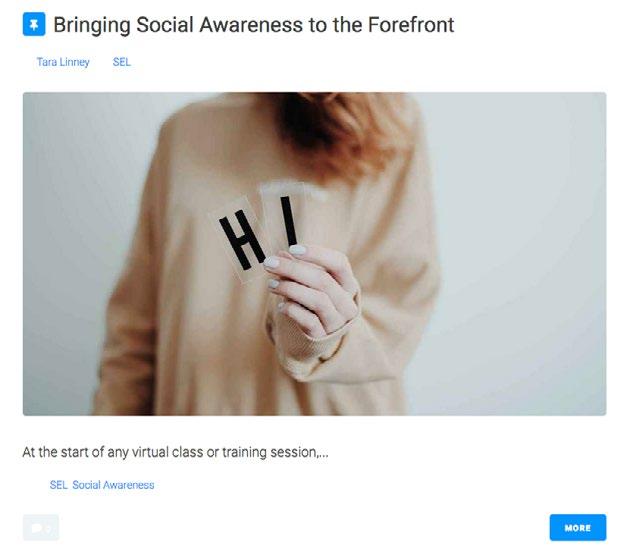
4 minute read
Book Review
Review by Monique Belin
Connecting with Students Online
by Jennifer Serravallo
Click the cover to view on Heinemann.
The coronavirus pandemic has tried to turn our lives upside down. It has impacted almost everyone since the spring of 2020 when educators had to quickly pivot to provide traditional inperson teaching practices into a remote learning format. While the pandemic has allowed teachers to dig deep into their creative teacher bag and find innovative ways to teach in a digital space, it has not changed the meaning of what great teaching looks like.
Drawing from feedback received from fellow educators, author Jennifer Serravallo wrote Connecting with Students Online, a book that discusses and shares over 50 strategies on how teachers can improve the quality of distant learning through seven C’s: collaborating, communicating, connecting, caring, conferring, clarity, and compassion.
Seravallo’s vision for this book was centered around how to lead small groups, provide assessments to students and monitor for understanding, and how to keep students engaged in a remote format utilizing the seven C’s with the hope that it will lead to students having a more meaningful remote learning
experience. Seravallo also wanted to offer a way for students and families to still seem connected through direct interactions remotely. She does so by guiding the reader through a series of concrete how-to strategies to help teachers continue to connect and support students.
Through six chapters, Serravallo gives readers a closer look inside her vision on how to make the reality of online what technology will be useful so that it can serve a variety of purposes in the educational process.
Serravallo begins the book by walking the reader through how crucial it is to continue to partner with families and caregivers at home to set students up for success. This is done by detailing how online schools can be set-up and organized to ensure that someone is supporting the student’s learning in
teaching possible by discussing tools that center around concrete How-To topics such as partnering with adults to create relationships at home, curriculum preparation, and reviewing for online instruction, handling time, supporting students’ asynchronously, and procedures for online teaching.
A noteworthy fact of this book is that not all strategies are centered strictly on the basis of technology and putting students on devices. Instead, it is much more beneficial to be able to pick a small handful of tech tools and apps and explicitly teach children how to use them. Doing so will allow teachers to concentrate on their pedagogy guiding addition to being a parent, caregiver, or even a tutor. This chapter also provides strategies for how teachers can communicate to welcome parents and families into the online classroom through online videos and surveys. This chapter also provides creative strategies to help families set up learning spaces for the students at home as well as strategies to help families know what to do when things get frustrating.
Serravallo then leads the reader on how to craft and adapt curriculum units for online instruction. Strategies are presented on how teachers can organize their lessons, resources, and materials, as well as clearly communicating with students
and families so that it is easily accessible. Concrete ways of collecting and using feedback so teachers can modify and adapt their instruction to fit the needs of students are also detailed. Serravallo explains strategies that will help teachers navigate checking and monitoring for students’ understanding through an online environment—a relatively easy task in a traditional classroom setting that is complicated by a screen.
Online learning doesn’t diminish the importance of students’ independent practice at home. Serravallo explains how teachers can organize their day and time in different content areas to emphasize how beneficial it is to get students off the screen. Technology is valuable to help students connect with peers and teachers, however, students can quickly get burned out if all of their time is spent online. Readers are provided with creative strategies so students are not spending all the online instruction time with their eyes glued to the screen.
Lastly, Serravallo concludes the book with a packed chapter centered on how to take almost every in-person teaching method and adapting it to fit into an online space. Organizing book clubs, conferring with students, planning mini- and strategies lessons, phonics instructions, guided reading, peer feedback, and even tips on how teachers can make themselves look great on camera are just a few of the things discussed in this chapter.
Connecting with Students Online is an excellent book for all educators and noneducators who have a connection to the education system. No matter if school districts are in-person, fully remote, or somewhere in between during this chaotic pandemic, Jennifer Seravallo’s book is a great read with useful strategies to stay connected with your students.
Monique Belin began her career teaching 7th and 8th Gateway to Technology alongside teaching 8th grade Algebra. She transitioned to Elementary Education where she dedicated 8 years as a classroom teacher teaching a variety of grade levels. She recently has had the opportunity to serve as an Instruction Coach for grades K-5 in Huntley School District while obtaining her Administrative degree in Education from National Louis University. Monique’s passion and greatest area of strengths are in building relationships, curriculum, and instruction, and equity and diversity. Follow Monique @monique_belin on Twitter!








